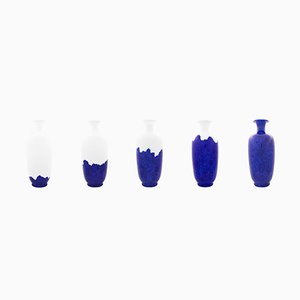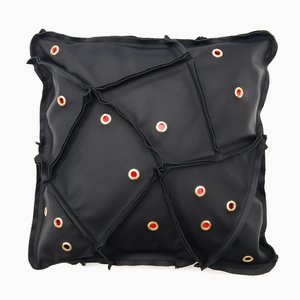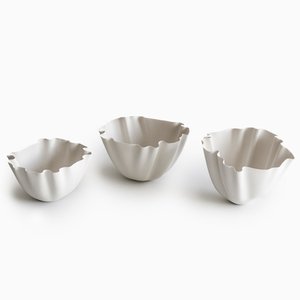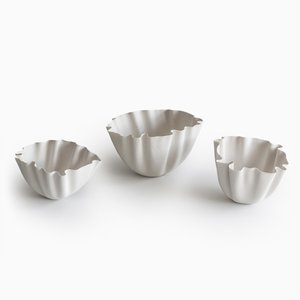Chris Chafin reviews New Territories at New York’s Museum of Arts & Design
Global Redux
-
Installation view of New Territories: Laboratories for Design, Craft and Art in Latin America at the Museum of Arts and Design, New York, 2014
Photo © Eric Scott
-
Artículo 6 from the series Artículo 6: Narratives of gender, strength and politics by Lucia Cuba, 2012-2014
Photo © Erasmo Wong Seoane
-
Informed consent / Meta-pieza from the series Artículo 6: Narratives of gender, strength and politics by Lucia Cuba, 2012-2014
Courtesy of the artist
-
Installation view of New Territories: Laboratories for Design, Craft and Art in Latin America at the Museum of Arts and Design, New York, 2014
Photo © Eric Scott
-
Stray Bullet Chair by Design da Gema, 2011
Photo © David Elia
-
Still from Urban Parasites by Gilberto Esparza, 2010-2014
Courtesy of the artist
-
Installation view of New Territories: Laboratories for Design, Craft and Art in Latin America at the Museum of Arts and Design, New York, 2014
Photo © Eric Scott
-
Installation view of work by Angellow García Bassi at New Territories: Laboratories for Design, Craft and Art in Latin America at the Museum of Arts and Design, New York, 2014
Photo © Eric Scott
-
Installation view of works by Sebastian Errazuriz at New Territories: Laboratories for Design, Craft and Art in Latin America at the Museum of Arts and Design, New York, 2014
Photo © Eric Scott
-
Installation view of New Territories: Laboratories for Design, Craft and Art in Latin America at the Museum of Arts and Design, New York, 2014
Photo © Eric Scott
-
Mask II (DCW) After Charles Eames by Edgar Orlaineta, 2013
Courtesy of the artist and Steve Turner Contemporary
-
Installation view of New Territories: Laboratories for Design, Craft and Art in Latin America at the Museum of Arts and Design, New York, 2014
Photo © Eric Scott
-
Alamar from the series Architecture of Necessity by Ernesto Oroza, 2005
Courtesy of the artist
-
Double Seat Barrel by Rolando Peña, 2013-2014
Courtesy of the artist
-
Hammock by Rodrigo Almeida, 2013
Photo © Studio Rodrigo Almeida
-
Servant Lamp from Slaves Series by Rodrigo Almeida, 2013
Photo © Studio Rodrigo Almeida
-
Installation view of New Territories: Laboratories for Design, Craft and Art in Latin America at the Museum of Arts and Design, New York, 2014
Photo © Eric Scott
-
Installation view of New Territories: Laboratories for Design, Craft and Art in Latin America at the Museum of Arts and Design, New York, 2014
Photo © Eric Scott
-
PET Lamp by Alvaro Catalán de Ocón, 2012
Photo © Studio Alvaro Catalán de Ocón
-
Autoconstrucción: Low Budget Rider by Abraham Cruzvillegas, 2009
Courtesy of the artist and Kurimanzutto, Mexico City
-
Installation view of New Territories: Laboratories for Design, Craft and Art in Latin America at the Museum of Arts and Design, New York, 2014
Photo © Eric Scott
-
Installation view of New Territories: Laboratories for Design, Craft and Art in Latin America at the Museum of Arts and Design, New York, 2014
Photo © Eric Scott
-
Ciudad Frondosa by Chiachio & Giannone, 2011-2012
Photo © MAD Museum
-
Installation view of New Territories: Laboratories for Design, Craft and Art in Latin America at the Museum of Arts and Design, New York, 2014
Photo © Eric Scott
-
Redemption by Guillermo Bert (woven by Anita Paillamil), 2012
Courtesy of a private collection
-
Installation view of New Territories: Laboratories for Design, Craft and Art in Latin America at the Museum of Arts and Design, New York, 2014
Photo © Eric Scott
-
Miss Delta Amacuro Chair by MáximaDuda (Mária Antonia Godigna and Anabella Georgi), 2006
Courtesy of the artist
-
Installation view of New Territories: Laboratories for Design, Craft and Art in Latin America at the Museum of Arts and Design, New York, 2014
Photo © Eric Scott
-
Orange Crush Fiberglass Wall Console by DFC (Tony Moxham & Mauricio Paniagua), 2013
Photo © Eric Scott
A few years ago, Glenn Adamson made a big splash in the New York art world. Adamson, who was at the time working at London’s Victoria & Albert Museum, wrote for Art In America a fairly damning indictment of Global Africa Project then showing at the Museum of Art & Design (MAD). He even had a few zingers to aim at the institution itself, which had changed its name from The American Craft Museum in 2002. “The new name seemed to have been chosen mainly for its vagueness,” he wrote. “All the arts, and design too?” The museum’s then director, Holly Hotchner, felt compelled to reply publically. When Adamson was named director of MAD in 2013, the article and attending controversy were rehashed in a New York Times story.
To this day, the story refuses to die. It was brought up again recently, at the opening of MAD’s latest exhibition, one of the first Adamson has overseen as director, New Territories: Laboratories for Design, Craft, and Art in Latin America. Small wonder. In his piece, Adamson had described his problems with basically everything about Global Africa, curated by Lowery Stokes Sims and Leslie King-Hammond, from its geographic focus to its seemingly arbitrary organization into six themes to how many objects it had put on display, right up to its name. “As soon as you hear the title,” he wrote, “you know trouble is coming.” It is therefore something of a surprise that New Territories is a geographically focused show, divided into six themes, curated by Lowery Stokes Sims. Perhaps Adamson forgot his earlier reservations? Speaking before its opening, he called Sims a “rather extraordinary curator” and referred to Global Africa as “a pioneering look at the continent of Africa and the diaspora.”
Sims was less circumspect. “Glenn and I have an old joke, because I did Global Africa and he was very critical of it,” she said. “One of the things he criticized was how much stuff we had—hopefully we did a better job this time. I did a walkthrough this morning, and thought, Oh, we’ve got a lot of space. Glenn will be happy.”
It’s not only in the layout that one can see the revisionist’s hand at work in New Territories. One of Adamson’s principal complaints in 2011 was the abandonment of the concept of craft, both by the museum at large and in the exhibition in particular. “Who actually fabricated the many elegant, traditionally informed fashion ensembles on display?” he wrote. “Do expatriate couturiers in London and Paris, such as Duro Olowu and Anggy Haïf, retain links to makers in Cape Town or Lagos, or is the garment industry in Africa entirely separated from the catwalk?”
This exhibition does not shy away from those questions, and indeed puts them, rightly, in the foreground. Throughout the exhibition’s second floor— it sprawls across three floors of MAD’s Columbus Circle home—are rugs, figurines, tapestries, and plates made as reactions to traditional crafts, sometimes with traditional craftspeople, and sometimes solely by the artists themselves. Beautiful pieces of clothing by the Mexican artist Carla Fernandez come with accompanying text describing the artist’s decade-long effort to help traditional weavers produce more fashion-forward clothing that can be sold on a global market; an accompanying video shows these weavers at work. A series of ceramic vessels by the artist Liliana Ovalle and Colectivo 1050º beautifully warp traditional Mexican pottery, turning them into sensuously distended organic structures. What’s more, the pieces were made in conjunction with regional craftsmen: Colectivo 1050º is dedicated to creating job opportunities and supporting economic development for women in the poorest parts of Oaxaca, Mexico.
This kind of work—partnering with local legacy craftspeople to bring their pieces to a larger (and more lucrative) market—is a very popular idea in economic development circles, and is being actively pursued everywhere from Michigan and Cambodia to the Arctic. A report from Craft Works! Michigan neatly sums up the thinking around these movements: promoting craft supports “economic growth, while valuing and engaging culture and personal creativity,” as well as honoring local traditions. This approach takes an already existing skill and finds a way to monetize it properly on the global market; further, and in economic terms, it tries to bring the price of the crafts closer to their value, giving the dividends to the individual craftspeople and their communities.
Some people, however, have criticized a focus on traditional crafts in economic development. In a 2010 paper, Michael Todd, of the University of Manchester’s Brooks World Poverty Institute, wrote that, “Without denigrating traditional crafts—there is clearly a place for promoting and protecting traditional crafts and culture—in terms of focusing on maximum potential for job creation and social impact, this paper encourages . . . an emphasis on [other] industries,” referring to 21st century (and indeed 20th century) creative businesses like film, television, architecture, and graphic design. While this language may sound mild, it’s actually quite harsh in the polite world of international development research papers.
Focusing development efforts around traditional crafts, the argument goes, is relatively small-bore change. The benefits will likely accrue only to the handful of craftspeople working with global artists, and not to their entire community, much less their entire country. More broadly, it shows something of a lack of imagination; a mistaken belief that the things people in developing nations already do are all the things they’re capable of doing. This is, of course, not the case. Nigeria, for example, has spent the last twenty years building a thriving film industry (colloquially referred to as “Nollywood”) that’s extremely popular throughout Africa and beyond, and worth roughly $5.1 billion in 2013, according to estimates from the Export-Import Bank of Nigeria. There’s also a more abstract set of problems and prejudices at play; programs to promote the development of craft may accomplish more in the area of a development worker’s desire to preserve the comfortably simple culture they work with than in perhaps more pressing economic, health, and technological matters.
It must be said that the exhibits in New Territories that deal with craft do so, by and large, in the most fair and forward-looking way possible. They work with individual craftsmen, who share in the credit and in many cases the revenue of the pieces being produced, to make pieces that truly meld traditional techniques and modern sensibilities. One wonders how scalable these efforts might be, but asking for a workable solution to global poverty from a museum show may be a bit unfair. The sections on craft are the exhibition’s best, and most fully express the show’s vision. The other five sections, however, leave something to be desired, and serve mainly as a trial by fire for buzzwords.
New Territories’ six sections are each pinned to a specific location: conversations with artistic legacies (Caracas, Venezuela); upcycling and repurposing objects (São Paulo/Rio de Janeiro, Brazil); cultivating collectivity and experimentation (Santiago, Chile/Buenos Aires, Argentina); developing new markets (San Salvador, El Salvador/San Juan, Puerto Rico); navigating personal and civic space (Havana, Cuba); and moving craft into the future through collaborations with artists and designers (Mexico City/Oaxaca, Mexico).
The clear winner, as mentioned, is craft. The others are less successful. It’s hard to look at the upcycling pieces—a tower of hairbrushes, a faux Eames Chair made of nuts (of the “nuts and bolts” variety, not the kind squirrels hide for winter)—and feel anything but longing for a return to the honesty of Dadism. When Duchamp attached a bicycle wheel to a stool, he was making a point about the art world, not about our careless treatment of old wheels.
There’s also something of a boundary problem. Why are Mexican artist Gilberto Esparza’s pieces—drone-like insects made from trash—grouped under the space rubric, which is tied to Cuba? They are made of old cell phones and spare wires, which certainly makes them upcycling. And while the artist does not live in Mexico City or Oaxaca, he’s definitely closer to those places than to Havana. The decision seems to be based on the rather squishy idea that his pieces somewhat resemble drones, which are used to monitor public spaces. Ergo, his work goes in the “spaces” section. The “experiments” section is not much better, featuring pieces that are either not particularly experimental (the beautiful but straightforward papercraft sculptures of Angello García Bassi) or not very new (the 15-year-old leather stools by Alejandro Sarmiento).
In his 2011 piece, Adamson asks a relatively simple question: “Why take on so much at once?” Not only in the scope of the work, but in trying to sum up the artistic output of an entire continent in one show. It’s an apt query to pose to New Frontiers as well, which actually has a somewhat larger focus: Mexico, Central America, parts of the Caribbean, and South America add up to a continent and a half. Ironically, its attempt to be more incisive—to not simply put “Latin American design” on display and leave it at that—has caused more problems than it's solved.
These are thorny issues in curation, and there are no easy answers. A less complicated goal might have been showcasing world-class designs, linked to traditional crafts. Or even more so, just world-class design coming from Latin America—pieces that could be on display in Salone or Frieze, no matter who produced them, or where. But then, as New Territories shows us, being critical of someone else’s exhibition is much easier than putting on your own.
-
Text by
-
Chris Chafin
Chris is a Brooklyn-based writer who's contributed to publications like Rolling Stone, Wired, Fast Company, and The Awl. He'd be flattered if you'd consider following him on Twitter
-
Découvrez plus de produits
Vases Imperial Marker par BrunoMMCarvalho, 2016, Set de 5

Coussin Stray Bullet par David Elia

Set en Étain par Liliana Ovalle, Set de 3

Vase Stray Bullet par David Elia

Less: No.1 Catenary Pottery Printer - Set One par gt2P

Less: No.1 Catenary Pottery Printer - Set Two par gt2P

Less: No.1 Catenary Pottery Printer - Set Three par gt2P

Less: No.1 Catenary Pottery Printer - Set Four par gt2P

Lustre PET Lamp par Alvaro Catalán de Ocón































 Square Chamula Coat, part of the Casa Barragan Collection, by Carla Fernández, 2008
Courtesy of the artist
Square Chamula Coat, part of the Casa Barragan Collection, by Carla Fernández, 2008
Courtesy of the artist
